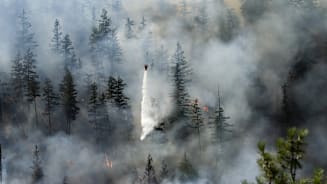
2025 Climate and Catastrophe Insight
As climate change affects the frequency and intensity of global natural disasters, how can organizations identify trends to protect people and property?
Economic losses from natural disaster events reached $368 billion in 2024 driven by Hurricanes Milton and Helene, severe convective storms in the U.S., and flooding across Europe.
These events demonstrate the critical role of adaptation and mitigation measures, as well as opportunities to better protect lives and enhance resilience.
Key Takeaways
- Hurricanes Helene and Milton emphasize the important role of effective building codes in reducing hurricane damage.
- Severe convective storm insured losses were the second highest on record, underscoring the need for better construction, maintenance and timely repairs.
- European flood drives $10 billion insured losses, revealing need for better preparedness, forecasts and warning systems.
- 2024 was the warmest year on record underscoring the importance of reliable climate data and analytics.
Extreme weather remains a powerful force driving the complexity and volatility that businesses and communities face and emphasizes the urgent need for innovative solutions to address this growing challenge.

Understanding the Protection Gap
The largest uninsured losses of the year were driven by tropical cyclone-related flooding, the Noto Earthquake in Japan and flood events across Asia, South America and Europe. With a protection gap of 75 percent in 2024, flood remains an underinsured peril – highlighting the global need for collaboration across the public and private sector to promote flood insurance adoption.
The global protection gap is the difference between total economic losses and what's covered by insurance. This remains a critical reference point as it describes the vulnerability of communities and the opportunity for new solutions.
Aon's Better Being Podcast
Our Better Being podcast series, hosted by Aon Chief Wellbeing Officer Rachel Fellowes, explores wellbeing strategies and resilience. This season we cover human sustainability, kindness in the workplace, how to measure wellbeing, managing grief and more.
-

Podcast 23 mins
Better Being Series: Understanding Burnout in the Workplace -

Podcast 14 mins
Better Being Series: Why Nutrition Matters -

Podcast 10 mins
Better Being Series: Discover the ‘Blue Zones’ Where People Live Longer -

Podcast 20 mins
Better Being Series: Improving Your Financial Wellbeing -

Podcast 17 mins
Better Being Series: Are You Taking Care of Your Digital Wellbeing? -

Podcast 19 mins
On Aon Podcast: Better Being Series Dives into Women’s Health -

Podcast 29 mins
On Aon’s Better Being Series: The World Wellbeing Movement -

Podcast 28 mins
On Aon’s Better Being Series: Mental Health and Creating Kinder Cultures -

Podcast 25 mins
On Aon’s Better Being Series: Managing Loss and Grief -

Podcast 24 mins
On Aon’s Better Being Series: Measuring Wellbeing -

Podcast 25 mins
On Aon’s Better Being Series: Physical Wellbeing and Resilience -

Podcast 23 mins
On Aon’s Better Being Series: Human Sustainability
Aon Insights Series Asia
Expert Views on Today's Risk Capital and Human Capital Issues
-

Article 8 mins
Thriving in an Interconnected World: How the C-Suite Embraces Uncertainty -

Article 6 mins
Powering Progress: Collaborating to Build a Sustainable Future in Emerging Markets -

Article 5 mins
Building Business Resilience: Key Steps to Effectively Integrate Risk Management Across Your Organisation -

Article 7 mins
Why Humans Are the Essential Factor in the Success of Artificial Intelligence (AI) -

Article 5 mins
Leveraging Research and Expertise to Strengthen Your HR Strategy for 2025 and Beyond -

Article 5 mins
Managing Risk on the Energy Transition Journey -

Article 7 mins
The Role of Risk Management in the Age of Generative Artificial Intelligence -

Article 7 mins
Finding A Way In Asia Pacific's New Economic Reality -

Article 4 mins
Three Ways to Boost Value from Benefits: APAC Insights from LinkedIn
Aon Insights Series Pacific
Expert Views on Today's Risk Capital and Human Capital Issues
Aon Insights Series UK
Expert Views on Today's Risk Capital and Human Capital Issues
-

Article 2 mins
Introduction: Clarity and Confidence to Make Better Decisions -

Article 2 mins
The Age of Rising Resilience – An Economic Outlook -

Article 3 mins
Building Resilience Against the Constant Cyber Threat -

Article 2 mins
Making Better Decisions – A Treasurer’s Perspective -

Article 2 mins
How to Balance the Conflicting Forces of Efficiency, Performance and Wellbeing -

Article 3 mins
Seizing the Opportunity: Building a Comprehensive Approach to Risk Transfer -

Article 2 mins
Tapping New Markets to Unlock Deal Value -

Article 5 mins
The Rise of the Skills-Based Organisation -

Article 2 mins
Creating a Fair and Equitable Workforce for Everyone -

Article 3 mins
The Year of the Vote: How Geopolitical Volatility Will Impact Businesses -

Article 2 mins
The Aon Difference
Client Trends 2025
Better Decisions Across Interconnected Risk and People Issues.
-

Article 3 mins
Acknowledging Our Complex Reality -

Article 10 mins
Trade in a Technology-Driven Future -

Article 9 mins
How AI and Workforce will Intersect: Navigating Risks and Opportunities -

Article 8 mins
Weather and Workforce: Employers Must Quantify the Risk -

Article 9 mins
Steering Trade and Supply Chains Amid Weather Challenges -

Report 13 mins
Trade Issues Confront Global Businesses on Multiple Fronts -

Report 19 mins
Technology is Driving Firms to Harness Opportunities and Defend Against Threats -

Report 19 mins
Climate Analytics Unlock Capital to Protect People and Property -

Report 14 mins
A Workforce in Transition Prepares to Meet a Host of Challenges
Construction and Infrastructure
The construction industry is under pressure from interconnected risks and notable macroeconomic developments. Learn how your organization can benefit from construction insurance and risk management.
-

Article 8 mins
How North American Construction Contractors Can Mitigate Emerging Risks -

Article 7 mins
Managing Construction Risks: 7 Risk Advisory Steps -

Article 7 mins
Unlocking Capacity and Capital in a Challenging Construction Risk Market -

Article 7 mins
Protecting North American Contractors from Extreme Heat Risks with Parametric -

Article 5 mins
How Climate Modeling Can Mitigate Risks and Improve Resilience in the Construction Industry -

Report 1 mins
Construction Risk Management Europe Report 2023 -

Article 8 mins
Parametric Can Help Mitigate Extreme Heat Risks for Contractors in EMEA -

Article 9 mins
How the Construction Industry is Navigating Climate Change -

Article 11 mins
Top Risks Facing Construction and Real Estate Organizations
Cyber Labs
Stay in the loop on today's most pressing cyber security matters.
-

Cyber Labs 8 mins
Bring Your Own Installer: Bypassing EDR Through Agent Version Change Interruption -

Cyber Labs 17 mins
Maximizing value: How companies and pentesters can achieve more together -

Cyber Labs 7 mins
DNSForge – Relaying with Force -

Cyber Labs 14 mins
We’re All in This Together: The Case for Purple Teaming -

Cyber Labs 7 mins
Parsing ESXi Logs for Incident Response with QELP -

Cyber Labs 5 mins
Parsing Jenkins Configuration Files for Forensics and Fun -

Cyber Labs 10 mins
Emerging Risks in Third-Party AI Solutions and How to Help Address Them -

Cyber Labs 20 mins
Unveiling the Dark Side: Common Attacks and Vulnerabilities in Industrial Control Systems -

Cyber Labs 9 mins
Mounted Guest EDR Bypass -

Cyber Labs 6 mins
Optimizing Your Cyber Resilience Strategy Through CISO and CRO Connectivity -

Cyber Labs 9 mins
Bypassing EDR through Retrosigned Drivers and System Time Manipulation -

Cyber Labs 10 mins
DNSForge – Responding with Force -

Cyber Labs 7 mins
Unveiling "sedexp": A Stealthy Linux Malware Exploiting udev Rules -

Cyber Labs 3 mins
Command Injection and Path Traversal in StoneFly Storage Concentrator -

Cyber Labs 7 mins
Adopt an AI Approach with Confidence, for CISOs and CIOs -

Cyber Labs 3 mins
Responding to the CrowdStrike Outage: Implications for Cyber and Technology Professionals -

Cyber Labs 10 mins
DUALITY Part II - Initial Access and Tradecraft Improvements -

Cyber Labs 17 mins
Cracking Into Password Requirements -

Cyber Labs 57 mins
DUALITY: Advanced Red Team Persistence through Self-Reinfecting DLL Backdoors for Unyielding Control -

Cyber Labs 7 mins
Restricted Admin Mode – Circumventing MFA On RDP Logons
Cyber Resilience
Our Cyber Resilience collection gives you access to Aon’s latest insights on the evolving landscape of cyber threats and risk mitigation measures. Reach out to our experts to discuss how to make the right decisions to strengthen your organization’s cyber resilience.
-

Article 8 mins
Cyber and E&O Market Conditions Remain Favorable Amid Emerging Global Risks -

Article 7 mins
How to Navigate AI-Driven Cyber Risks -

Article 9 mins
Building Resilience in a Buyer-Friendly Cyber and E&O Market -

Article 11 mins
A Middle Market Roadmap for Cyber Resilience -

Article 7 mins
Lessons Learned from the CrowdStrike Outage: 5 Strategies to Build Cyber Resilience -

Article 8 mins
Responding to Cyber Attacks: How Directors and Officers and Cyber Policies Differ -

Article 7 mins
Why Now is the Right Time to Customize Cyber and E&O Contracts -

Article 6 mins
8 Steps Toward Building Better Resilience Against Rising Ransomware Attacks -

Article 7 mins
Mitigating Insider Threats: Managing Cyber Perils While Traveling Globally -

Article 4 mins
Managing Cyber Risk through Return on Security Investment -

Article 10 mins
Mitigating Insider Threats: Your Worst Cyber Threats Could be Coming from Inside -

Article 9 mins
Why HR Leaders Must Help Drive Cyber Security Agenda -

Article 10 mins
Escalating Cyber Security Risks Mean Businesses Need to Build Resilience
Employee Wellbeing
Our Employee Wellbeing collection gives you access to the latest insights from Aon's human capital team. You can also reach out to the team at any time for assistance with your employee wellbeing needs.
-

Article 8 mins
Employer Strategies for Cancer Prevention and Treatment -

Article 6 mins
The Long-Term Care Conundrum in the United States -

Article 9 mins
Developing a Paid Leave Strategy That Supports Workers and Their Families -

Article 9 mins
4 Ways to Foster a Thriving Workforce Amid Rising Health Costs -

Article 9 mins
The Next Evolution of Wellbeing is About Performance -

Article 6 mins
Three Ways Collective Retirement Plans Support HR Priorities -

Article 9 mins
How the Right Employee Wellbeing Strategy Impacts Microstress and Burnout at Work -

Podcast 13 mins
On Aon Podcast: The Future of Healthcare: Key Factors Impacting Medical Trend Rates -

Article 7 mins
Making Wellbeing Part of a Company’s DNA -

Article 7 mins
A Comprehensive Approach to Financial Wellbeing
Environmental, Social and Governance Insights
Explore Aon's latest environmental social and governance (ESG) insights.
-

Podcast 16 mins
On Aon Podcast: Approach to DE&I in the Workplace
Q4 2023 Global Insurance Market Insights
Our Global Insurance Market Insights highlight insurance market trends across pricing, capacity, underwriting, limits, deductibles and coverages.
-

Article 12 mins
Q4 2023: Global Insurance Market Overview -

Article 13 mins
Top Risk Trends to Watch in 2024
Regional Results
How do the top risks on business leaders’ minds differ by region and how can these risks be mitigated? Explore the regional results to learn more.
-

Article 12 mins
Top Risks Facing Organizations in Asia Pacific -

Article 12 mins
Top Risks Facing Organizations in North America -

Article 10 mins
Top Risks Facing Organizations in Europe -

Article 8 mins
Top Risks Facing Organizations in Latin America -

Article 8 mins
Top Risks Facing Organizations in the Middle East and Africa -

Article 9 mins
Top Risks Facing Organizations in the United Kingdom
Human Capital Analytics
Our Human Capital Analytics collection gives you access to the latest insights from Aon's human capital team. Contact us to learn how Aon’s analytics capabilities helps organizations make better workforce decisions.
-

Article 35 mins
5 Human Resources Trends to Watch in 2025 -

Article 13 mins
Medical Rate Trends and Mitigation Strategies Across the Globe -

Article 9 mins
3 Strategies to Help Avoid Workers Compensation Claims Litigation -

Podcast 15 mins
On Aon Podcast: Using Data and Analytics to Improve Health Outcomes -

Article 14 mins
How Technology Will Transform Employee Benefits in the Next Five Years -

Podcast 18 mins
On Aon Podcast: Technology Impacting the Future of Health and Benefits -

Article 8 mins
Integrating Workforce Data to Uncover Hidden Insights -

Podcast 24 mins
On Aon’s Better Being Series: Measuring Wellbeing -

Article 11 mins
Designing Tomorrow: Personalizing EVP, Benefits and Total Rewards
Human Capital Quarterly Insights Briefs
Read our collection of human capital articles that explore in depth hot topics for HR and risk professionals, including using data and analytics to measure total rewards programs, how HR and finance can better partner and the impact AI will have on the workforce.
-

Article 35 mins
5 Human Resources Trends to Watch in 2025 -

Article 20 mins
5 Ways HR Can Partner with Finance to Drive Growth -

Article 15 mins
How Artificial Intelligence is Transforming Human Resources and the Workforce -

Article 17 mins
Five Big Human Resources Trends to Watch in 2024 -

Article 11 mins
Designing Tomorrow: Personalizing EVP, Benefits and Total Rewards -

Article 10 mins
How Data and Analytics Can Optimize HR Programs -

Article 11 mins
Get Ready for the Top 5 HR Trends in 2023
Insights for HR
Explore our hand-picked insights for human resources professionals.
-

Article 7 mins
COVID-19 has Permanently Changed the Way We Think About Wellbeing -

Article 7 mins
DE&I in Benefits Plans: A Global Perspective -

Article 10 mins
How Data and Analytics Can Optimize HR Programs -

Article 9 mins
Why HR Leaders Must Help Drive Cyber Security Agenda -

Article 7 mins
Case Study: The LPGA Unlocks Talent Potential with Data -

Article 11 mins
Navigating the New EU Directive on Pay Transparency -

Article 4 mins
How to Design Better Talent Assessment to Promote DE&I -

Article 6 mins
Training and Transforming Managers for the Future of Work -

Article 7 mins
Rethinking Your Total Rewards Programs During Mergers and Acquisitions -

Article 14 mins
Building a Resilient Workforce That Steers Organizational Success | An Outlook Across Industries
Workforce
Our Workforce Collection provides access to the latest insights from Aon’s Human Capital team on topics ranging from health and benefits, retirement and talent practices. You can reach out to our team at any time to learn how we can help address emerging workforce challenges.
-

Article 8 mins
Weather and Workforce: Employers Must Quantify the Risk -

Article 35 mins
5 Human Resources Trends to Watch in 2025 -

Article 19 mins
3 Strategies to Promote an Inclusive Environment and Bridge the Gender Gap -

Article 8 mins
2025 Salary Increase Planning Tips -

Article 8 mins
Employer Strategies for Cancer Prevention and Treatment -

Article 12 mins
Understanding and Preparing for the Rise in Pay Transparency -

Podcast 12 mins
Better Being Series: Building Sustainable Performance in a Multi-Generational Workforce -

Article 7 mins
Key Trends in U.S. Benefits for 2025 and Beyond -

Article 8 mins
Pay Transparency Can Lead to Better Equity Across Benefits -

Article 17 mins
3 Strategies to Improve Career Outcomes for Older Employees -

Article 9 mins
Developing a Paid Leave Strategy That Supports Workers and Their Families -

Article 9 mins
4 Ways to Foster a Thriving Workforce Amid Rising Health Costs
Mergers and Acquisitions
Our Mergers and Acquisitions (M&A) collection gives you access to the latest insights from Aon's thought leaders to help dealmakers make better decisions. Explore our latest insights and reach out to the team at any time for assistance with transaction challenges and opportunities.
-

Article 8 mins
Exit Strategy Value Creation Opportunities Exist as Economic Pressures Persist -

Article 5 mins
Future Trends for Financial Sponsors: Secondary Transactions -

Article 8 mins
3 Ways to Unlock M&A Value in a Challenging Credit Environment -

Article 7 mins
Rethinking Your Total Rewards Programs During Mergers and Acquisitions -

Article 9 mins
Organizational Design and Talent Planning are Key to M&A Success -

Article 7 mins
An Ever-Complex Global Tax Environment Requires Strong M&A Risk Solutions -

Article 5 mins
Project Management for HR: The Secret Behind a Successful M&A Deal -

Article 9 mins
Cultural Alignment Planning Drives M&A Success -

Report 1 mins
A Guide to Maximizing Value in Post-Merger Integrations -

Report 2 mins
The ABC's of Private Equity M&A: Deal Flow Impacts of Al, Big Tech and Climate Change -

Article 11 mins
The Silver Lining on M&A Deal Clouds: M&A Insurance Insights from 2023
Natural Resources and Energy Transition
The challenges in adopting renewable energy are changing with technological advancements, increasing market competition and numerous financial support mechanisms. Learn how your organization can benefit from our renewables solutions.
-

Article 4 mins
5 Steps for Successful Carbon Accounting Verification -

Article 6 mins
AI Innovations in Renewable Energy: Transforming the Sector -

Article 11 mins
Securing Human Capital in Natural Resources -

Article 6 mins
Decarbonizing Construction for a Low-Emission Future
Navigating Volatility
How do businesses navigate their way through new forms of volatility and make decisions that protect and grow their organizations?
Parametric Insurance
Our Parametric Insurance Collection provides ways your organization can benefit from this simple, straightforward and fast-paying risk transfer solution. Reach out to learn how we can help you make better decisions to manage your catastrophe exposures and near-term volatility.
-

Article 10 mins
How Public Entities and Businesses Can Use Parametric for Emergency Funding -

Article 6 mins
Parametric Insurance: A Complement to Traditional Property Coverage -

Article 8 mins
Using Parametric Insurance to Match Capital to Climate Risk -

Article 6 mins
Using Parametric Insurance to Close the Earthquake Protection Gap -

Article 5 mins
How Technology Enhancements are Boosting Parametric
Pay Transparency and Equity
Our Pay Transparency and Equity collection gives you access to the latest insights from Aon's human capital team on topics ranging from pay equity to diversity, equity and inclusion. Contact us to learn how we can help your organization address these issues.
-

Article 19 mins
3 Strategies to Promote an Inclusive Environment and Bridge the Gender Gap -

Report 1 mins
The 2024 North America Pay Transparency Readiness Study -

Article 10 mins
How Financial Institutions can Prepare for Pay Transparency Legislation -

Article 8 mins
Pay Transparency Can Lead to Better Equity Across Benefits -

Article 12 mins
Understanding and Preparing for the Rise in Pay Transparency -

Podcast 14 mins
On Aon Podcast: Understanding Pay Transparency Regulations -

Article 11 mins
Navigating the New EU Directive on Pay Transparency -

Article 7 mins
To Disclose Pay or Not? How Companies are Approaching the Pay Transparency Movement -

Podcast 19 mins
On Aon Podcast: Better Being Series Dives into Women’s Health -

Article 11 mins
Advancing Women’s Health and Equity Through Benefits and Support
Property Risk Management
Forecasters are predicting an extremely active 2024 Atlantic hurricane season. Take measures to build resilience to mitigate risk for hurricane-prone properties.
-

Article 8 mins
Florida Hurricanes Not Expected to Adversely Affect Property Market -

Article 10 mins
Build Resilience for an Extremely Active Atlantic Hurricane Season -

Article 6 mins
Four Steps to Develop Strong Property Risk Coverage in a Hardening Market -

Podcast 16 mins
On Aon Podcast: Navigating and Preparing for Catastrophes -

Article 6 mins
Parametric Insurance: A Complement to Traditional Property Coverage -

Article 4 mins
Navigating Climate Risk Using Multiple Models and Data Sets -

Article 5 mins
Rising Losses From Severe Convection Storms Mostly Explained by Exposure Growth -

Article 6 mins
Using Parametric Insurance to Close the Earthquake Protection Gap
Technology
Our Technology Collection provides access to the latest insights from Aon's thought leaders on navigating the evolving risks and opportunities of technology. Reach out to the team to learn how we can help you use technology to make better decisions for the future.
-

Article 9 mins
How AI and Workforce will Intersect: Navigating Risks and Opportunities -

Article 23 mins
The AI Data Center Boom: Strategies for Sustainable Growth and Risk Management -

Article 7 mins
How Technology is Transforming Open Enrollment in the U.S. -

Article 15 mins
Navigating Cyber Risks in EMEA: Key Insights for 2025 -

Article 7 mins
How to Navigate AI-Driven Cyber Risks -

Article 15 mins
How Artificial Intelligence is Transforming Human Resources and the Workforce -

Alert 3 mins
Better Decisions Brief: Perspectives on the CrowdStrike Outage -

Podcast 9 mins
On Aon Podcast: How has CrowdStrike Changed the Cyber Market? -

Article 12 mins
5 Ways Artificial Intelligence can Boost Claims Management -

Article 12 mins
Navigating AI-Related Risks: A Guide for Directors and Officers -

Article 5 mins
How Technology Enhancements are Boosting Parametric -

Article 9 mins
How to Futureproof Data and Analytics Capabilities for Reinsurers
Top 10 Global Risks
Trade, technology, weather and workforce stability are the central forces in today’s risk landscape.
-

Article 7 mins
Cyber Attack or Data Breach -

Article 4 mins
Business Interruption -

Article 4 mins
Economic Slowdown or Slow Recovery -

Article 5 mins
Failure to Attract or Retain Top Talent -

Article 5 mins
Regulatory or Legislative Changes -

Article 4 mins
Supply Chain or Distribution Failure -

Article 6 mins
Commodity Price Risk or Scarcity of Materials -

Article 4 mins
Damage to Brand or Reputation -

Article 5 mins
Failure to Innovate or Meet Customer Needs -

Article 4 mins
Increasing Competition -

Report 3 mins
Business Decision Maker Survey
Trade
Our Trade Collection gives you access to the latest insights from Aon's thought leaders on navigating the evolving risks and opportunities for international business. Reach out to our team to understand how to make better decisions around macro trends and why they matter to businesses.
-

Article 10 mins
Trade in a Technology-Driven Future -

Podcast 9 mins
Special Edition: Global Trade and its Impact on Supply Chain -

Article 8 mins
The Evolving Threat of Cargo Theft: 5 Key Mitigation Strategies -

Report 3 mins
Global Risk Management Survey -

Article 6 mins
Four Steps to Develop Strong Property Risk Coverage in a Hardening Market -

Article 14 mins
Cutting Supply Chains: How to Achieve More Reward with Less Risk -

Article 9 mins
Driving Private Equity Value Creation Through Credit Solutions -

Article 7 mins
4 Steps to Help Take Advantage of a Buyer-Friendly Directors' & Officers' Market -

Article 9 mins
Managing Reputational Risks in Global Supply Chains -

Article 8 mins
How an Outsourced Chief Investment Officer Can Help Improve Governance and Manage Complexity -

Article 8 mins
Decarbonizing Your Business: Finding the Right Insurance and Strategy -

Article 8 mins
Reputation Analytics as a Leading Indicator of ESG Risk
Weather
With a changing climate, organizations in all sectors will need to protect their people and physical assets, reduce their carbon footprint, and invest in new solutions to thrive. Our Weather Collection provides you with critical insights to be prepared.
-

Article 9 mins
Steering Trade and Supply Chains Amid Weather Challenges -

Podcast 9 mins
On Aon Podcast: Climate Impact on the Property and Casualty Market -

Alert 14 mins
L.A. Wildfires Highlight Urgent Need for Employee Support and Business Resilience -

Report 2 mins
Climate and Catastrophe Insight -

Article 10 mins
How Public Entities and Businesses Can Use Parametric for Emergency Funding -

Podcast 12 mins
On Aon Podcast: Tackling Climate Risk to Build Economic Resilience -

Article 8 mins
Understanding Freeze Risk in a Changing Climate -

Podcast 9 mins
On Aon Podcast: Climate Science Through Academic Collaboration -

Article 6 mins
How Companies Are Using Climate Modeling to Improve Risk Decisions -

Article 8 mins
Using Parametric Insurance to Match Capital to Climate Risk -

Article 9 mins
How the Construction Industry is Navigating Climate Change -

Article 9 mins
Record Heatwaves: Protecting Employee Health and Safety
Workforce Resilience
Our Workforce Resilience collection gives you access to the latest insights from Aon's Human Capital team. You can reach out to the team at any time for questions about how we can assess gaps and help build a more resilience workforce.
-

Article 4 mins
Using Data to Close Workforce Gaps in Financial Institutions -

Article 5 mins
Using Data to Close Workforce Gaps in Retail Companies -

Article 7 mins
Using Data to Close Workforce Gaps in Technology Companies -

Article 4 mins
Using Data to Close Workforce Gaps in Manufacturing Companies -

Article 6 mins
Using Data to Close Workforce Gaps in Life Sciences Companies -

Report 4 mins
Measure Workforce Resilience for Better Business Outcomes -

Podcast 18 mins
On Aon Podcast: Methodology to Predict Employee Performance for the LPGA -

Article 6 mins
Training and Transforming Managers for the Future of Work -

Article 14 mins
Building a Resilient Workforce That Steers Organizational Success | An Outlook Across Industries
More Like This
-

Article
How Public Entities and Businesses Can Use Parametric for Emergency Funding
As climate change intensifies the frequency and severity of weather events, companies need more flexible funding solutions. Parametric stands out as an adaptable resource capable of swiftly responding to potential disasters.
Find Out More -

Article
Energy Transition Investments: How Advanced Analytics Can Empower Organizations
Advanced analytics can empower organizations with deeper insights into the risks and opportunities surrounding renewables, while also supporting energy transition investment.
Find Out More -

Article
Build Resilience for an Extremely Active Atlantic Hurricane Season
Record-warm Atlantic Ocean temperatures and a transition to La Niña conditions have led to an extremely active Atlantic hurricane season in 2024. Learn how to build business resilience to mitigate risk for hurricane-prone properties.
Find Out More

Ready to Explore Further?
Receive Catastrophe Event Recaps Throughout the Year
Turn insights into action for enhanced risk mitigation and seize opportunities.

Let’s Connect
Talk to Our Team
How can we help your organization navigate the impact of climate change and seize opportunities?
Contact Us